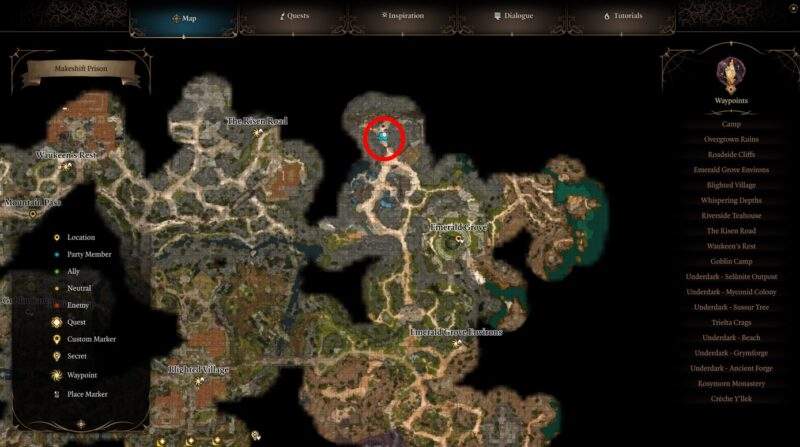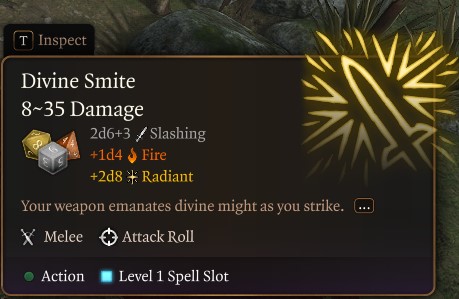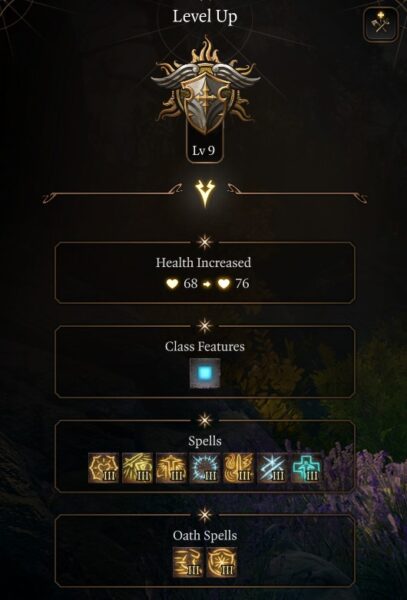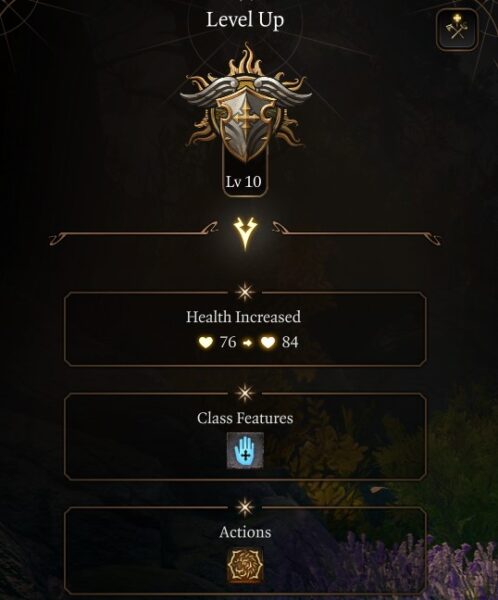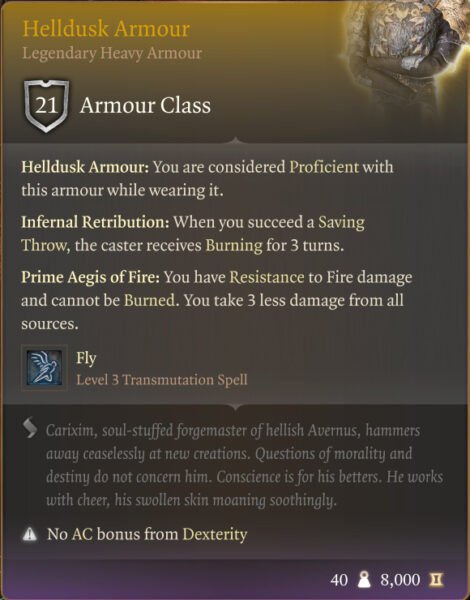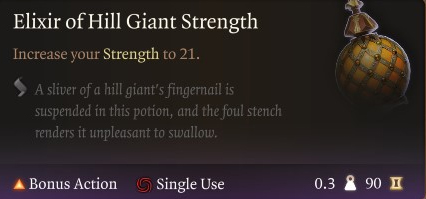This guide will explain the best Minthara Companion Build in Baldur’s Gate 3, the Paladin Class, and the Oath of Vengeance subclass, for the optimal setup.

This build page has been updated for the Patch 8 version of Baldur’s Gate 3.
Minthara Companion Introduction
Minthara is a Drow Paladin planning to take down the Druid Grove in the name of the Absolute. You encounter her during Act 1 in the Goblin Camp, where she serves as one of its three leaders. Players can join her and help her slaughter the Druid Grove or kill her if they decide to side with Halsin. If she lives, she can eventually join the party in Act 2 as a powerful Paladin companion. Her build focuses on using spells and abilities to deal high single-target damage. You want to build Minthara for single-target burst damage with a lot of debuff utility.
In this Minthara build guide for BG3, we will explore her character and how to make a powerful Paladin build with her. We also suggest using the Respec or Reroll feature to change Minthara’s default ability score distribution. Look below for options on gear, armour, and spells with this Baldur’s Gate 3 Minthara companion build guide.
| Pros of Minthara Build | Cons of Minthara Build |
|---|---|
| Crowd Control | Spell Slot Starved |
| High Burst Damage | Limited Spells |
| Heavy Armour | Complex |
Minthara Paladin Build Changes in Patch 8

The most significant updates to the Minthara Paladin build in Patch 8 of Baldur’s Gate 3 stem from the introduction of new subclasses, spells, and cantrips. While the core combat strategy remains largely unchanged, these additions open the door to powerful new multiclassing options that enhance both versatility and damage potential.
Moreover, the Booming Blade cantrip now offers a better advantage by adding thunder damage to each attack, making it a strong option. This is especially true when multiclassing into Hexblade Warlock, Sorcerer, or Wizard. As a companion, you cannot change Minthara’s appearance, gender, or race, but you can reroll and multiclass her build however you like.
Minthara Features & Mechanics
The following list presents all the essential Oath of Vengeance Paladin Class Mechanics and Minthara companion Features in Baldur’s Gate 3:
- Class: Paladin
- Race: Drow
- Background: Noble
- Subclass: Reroll to Oath of Vengeance
- Base Proficiencies: Athletics, Insight, Intimidation, Medicine, Persuasion, Religion
- Best Build: Paladin, Oath of Vengeance
- Preferred Gear: Two-handed Greatsword with Full Plate Armor
- Origin Character: No
- Romance: Yes
- Location: Goblin Camp in the Shattered Sanctum, Act 1; Moonrise Towers, Act 2
- Primary Ability: Charisma
- Armor Proficiency: Heavy Armour
- Weapon Proficiency: Martial and Simple
- Preferred Weapon: Two-hand Greatsword
- Preferred Armor: Full Heavy Platemail
- Channeled Oath Charges: Paladin-specific resource that allows the casting of spells and abilities.
- Divine Smite: Spend spell slots to deal additional radiant damage on a successful melee attack.
- Divine Health: The divine magic flowing within you prevents the disease from affecting you.
- Abjure Enemy: Frighten an enemy, Fiends and undead have a Disadvantage on this Saving Throw.
- Vow of Enmity: Gain Advantage on Attack Rolls against an enemy.
Your companion can be respecced or rerolled early in the game. This means you can change their class, subclass, ability score, and more. The only feature that cannot be adjusted is their race and story. We suggest using Withers at Camp after she’s unlocked to optimize the build. Minthara’s origin story is based on being a Paladin and we are suggesting you stick to that build, using the most powerful Vengeance subclass.
Paladin Spell Mechanics
- Cantrips: are like spells, but you can cast them infinitely, and they don’t take your spell slots.
- Spell Slots: will use your spell slots, which are a limited resource during combat and will require a long rest to refill.
- Prepared Spells: a Paladin mechanic that allows you to swap in and out spells before combat.
- Concentration: is a spell mechanic in Baldur’s Gate 3 that some Spells require to maintain and keep their magic active.
Paladin spell casting, in general, is limited compared to other classes and builds. But the Divine Smite additional damage mechanic, consuming spell slots, is the real reason you can do an amazing amount of damage. In general, save the spell slots for this usage unless you need a buff, heal, or crowd control. The Paladin is one of the strongest classes in the game, and it can be complex when playing the Minthara Build in BG3.
How to Find Minthara
Minthara can become one of your companions during Act 2 only if you decide to take down the Druid Grove and side with goblins or knock her out instead of killing her. The former path won’t let you recruit Halsin. Here is how to recruit Minthara in Baldur’s Gate 3:
- Complete the prologue.
- Head to the Druid Grove and once there, learn about the situation with Goblins.
- Locate Shazza in the cage, a goblin captured during the attack.
- Talk to her and learn more about goblins.
- Free Shazza and help her escape the Druid Grove, she will promise to introduce you to the Goblins. (use the passage at the back of the chamber where Shazza is imprisoned – Jump on the rocky shelf behind her cage)
- Follow Shazza to the Goblin Camp and find Minthara
- Agree to help her kill everyone in the Druid Grove
- Follow the quest to kill the druids
- Complete the quest and party sequence.
- In Act 2, travel to Moonrise Towers before the final confrontation and find Minthara in the prison.
- Rescue her, and convince her to join your party.
If you aren’t choosing the evil path to massacre the Emerald Grove’s residents, you can instead toggle Non-Lethal Attacks while fighting Minthara to spare her life. She can then be recruited during Act 2 in the same way stated above.
Related:
Minthara Class and Best Subclasses
The Oath of Vengeance subclass is a great Paladin subclass in Baldur’s Gate 3 because it offers powerful damage abilities, debuffs, and high survivability. Unlike Oathbreaker, you will be able to access this straight away from level 1. This subclass also focuses on damage, not healing or utility which is great for Minthara’s personality and we recommend it strongly for the Baldur’s Gate 3 Best Minthara Companion Build Guide.
Depending on your playstyle, you may break your Oath, which will cause you to be an Oathbreaker Paladin. You can choose to go down this path, and the only variations to the build will be some skills and spells. The gear, consumables, and most of the gameplay will be the same. Be aware though, if you are using Minthara and play evil, she will become an Oathbreaker Paladin. Both subclasses are great, just consider your roleplay and her narrative.
Here are all the Baldur’s Gate 3 Paladin subclasses:
- Oathbreaker: Damage-focused, crowd control, and control undead.
- Oath of the Ancients: Nature-based spell-focused, natural world Paladin.
- Oath of Devotion: Healing focused, radiant damage, “good” Paladin.
- Oath of Vengeance: Seeks revenge and deals extra damage when marking enemies.
- Oath of the Crown: Upholds the tenets of civilization. Buffs party members and taunts enemies.
Baldur’s Gate 3 Oath of Vengeance Paladin Features & Progression
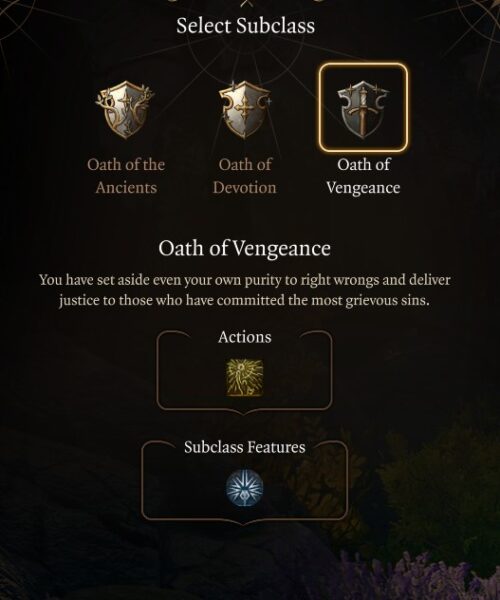
The Oath of Vengeance subclass unlocks the following features and spells:
- Oath of Vengeance Tenets (Level 1): Oath of Vengeance Paladins abide by the following tenets: Fight the Greater Evil. Exerting your wisdom, identify the higher morality in any given instance, and fight for it. No Mercy for the Wicked. Chasten those who dole out their villainy by wiping their blight from the world forever.
- Inquisitor’s Might (Level 1): You or an ally’s weapon attacks deal additional Radiant damage equal to your charisma modifier (minimum of 1) and can Daze enemies for 2 turns.
- Abjure Enemy (Level 3): Frighten an enemy. They’ll be easier to hit and cannot move. Fiends and undead have Disadvantages on this Saving Throw.
- Vow of Enmity (Level 3): Gain Advantage on Attack Rolls against an enemy.
- Oath Spells (Level 3): Band and Hunter’s Mark
- Oath Spells (Level 5): Misty Step and Hold Person
- Relentless Avenger (Level 7): If you hit an enemy with an Opportunity Attack, gain 4.5m movement next turn.
- Oath Spells (Level 9): Haste and Protection from Energy
Paladin Divine Smite Explained
Divine Smite is a signature ability of the Paladin class in Baldur’s Gate 3. It allows a Paladin to expend a spell slot to deal additional radiant damage to a creature they have hit with a melee weapon attack. The amount of extra damage is equal to 2d8 for a 1st-level spell slot, plus 1d8 for each spell level higher than 1st. The damage increases by 1d8 if the target is an undead or a fiend.
Divine Smite can be toggled on or off in the reactions menu under the user interface. This allows you to make a decision if you want to use it or not. This is very important because the Paladin can run out of Spell Slots quickly, limiting damage. The last thing you want is to expend a spell slot needlessly on a weak creature.
Here are some tips for using the Best Paladin Build to use Divine Smite effectively in Baldur’s Gate 3:
- Save your higher-level spell slots for tougher enemies.
- Use Divine Smite against enemies that are vulnerable to radiant damage.
- Consider using Divine Smite on a critical hit, as this will maximize the amount of damage you deal.
- Don’t be afraid to use Divine Smite multiple times per turn, especially if you are facing a group of enemies.
Character Creation for Minthara Companion Build
| Category | Selection |
|---|---|
| Character | Origin – Minthara |
| Race | Lolth-sworn Drow |
| Racial Bonus | Superior Darkvision, Fey Ancestry, Drow Weapon Training |
| Class | Paladin |
| Subclass | Oath of Vengeance |
| Cantrips | Dancing Lights |
| Spells | Searing Smite, Thunderous Smite, Shield of Faith, Divine Favour, Cure Wounds |
| Background | Noble |
| Ability Score | STR: 16 DEX: 10 CON: 14 INT: 8 WIS: 10 CHA: 16 |
| Skill Proficiencies | Athletics and Insight |
Minthara Race
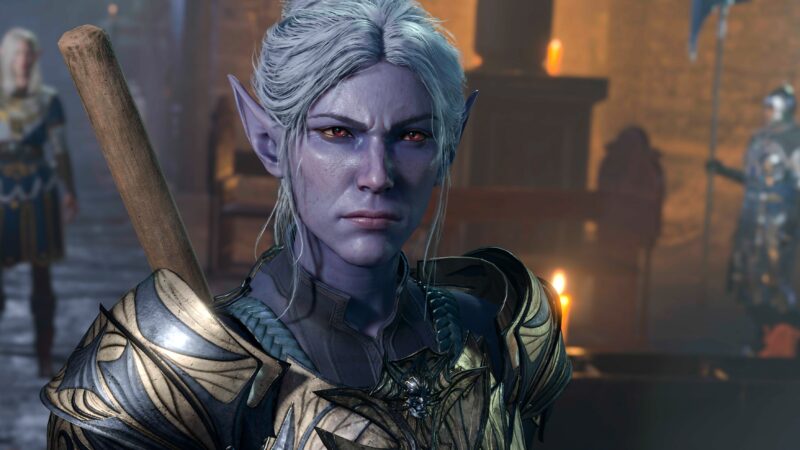
Minthara is a Lolth Sworn Drow, the race of elves dwelling in the depths of the Underdark. You can’t change her race, but Drow is a decent choice for many builds, including Paladin. Consider the Drow a strong general race that fits well with our Baldur’s Gate 3 best Minthara build. Here are the Drow Race bonuses:
- +2 and +1 to any ability score of your choosing
- Base Racial Speed
- The distance a race can travel in a single turn. For most races, including the Drow, this is 9 meters.
- Fey Ancestry
- Advantage on saving throws when an enemy attempts to charm you and prevents you from being put to sleep by potions, scrolls and spells.
- Superior Darkvision
- Can see in the dark up to 24 meters.
- Proficiency in Rapier, Shortsword, and Hand Crossbow
Drow Spellcasting:
- Dancing Lights (Cantrip)
- Create wisps of light that illuminate a 12m radius. Available at level 1.
- Faerie Fire
- Encase multiple targets in colorful light. The targets turns visible, and attack rolls against the targets have Advantage.
- Unlocks at level 3. Can cast once per long rest.
- Darkness
- Create a cloud of magical darkness to Heavily Obscure and Blind creatures within. Creatures cannot make ranged attacks into or out of the darkness
- Unlocks at level 5. Can cast once per long rest.
Recommended Skills for Minthara

Athletics and Insight are the best skills to invest in for Minthara because they already have a high score, creating a specialized skill set. Athletics is the most useful, since it will allow Minthara to perform well on checks during shoving or upon being shoved. Insight will only come into play if you use Minthara as the lead character and initiate conversations with her.
Here are the best skills for Minthara in Baldur’s Gate 3:
- Athletics is a Strength skill
- Insight is a Wisdom skill
By default, Minthara has proficiency in Athletics, Insight, Intimidation, Medicine, Persuasion, and Religion.
Minthara Ability Score
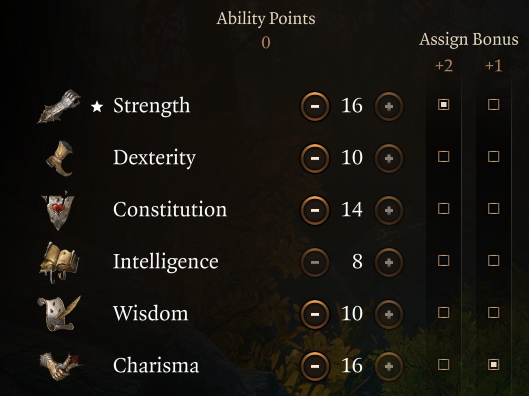
Below is the optimal ability score distribution for our best Minthara build in BG3:
| Ability | Points Goal |
|---|---|
| Strength | 16 |
| Dexterity | 10 |
| Constitution | 14 |
| Intelligence | 8 |
| Wisdom | 10 |
| Charisma | 16 |
The best Minthara ability scores for her Paladin build are 16 Strength and 16 Charisma, which make her melee abilities deal a lot of damage in combination with spells, specifically Divine Smite. The next priority is Constitution to 14, so you have a larger enough health pool to survive. Reaching 16 Strength and 16 Charisma is critical for the Paladin’s optimal damage setup.
In Baldur’s Gate 3, ability scores are the six core stats that determine a character’s capabilities. For companions, the game automatically distributes them without the ability to change initially. However you can change their default ability scores in your camp via the NPC Withers for 100 gold. Originally Minthara might have an odd ability score distribution and it is not ideal for a Charisma-based spellcaster. When you re-roll the ability scores, aim for 16 Strength and Charisma to create the best Minthara companion build.
Paladin Spell Slots
Below is a list and chart that shows the levels and spell slots unlocked for the Paladin class in Baldur’s Gate 3:
| Paladin Level | 1st | 2nd | 3rd |
|---|---|---|---|
| Level 1 | 0 | 0 | 0 |
| Level 2 | 2 | 0 | 0 |
| Level 3 | 3 | 0 | 0 |
| Level 4 | 3 | 0 | 0 |
| Level 5 | 4 | 2 | 0 |
| Level 6 | 4 | 2 | 0 |
| Level 7 | 4 | 3 | 0 |
| Level 8 | 4 | 3 | 0 |
| Level 9 | 4 | 3 | 2 |
| Level 10 | 4 | 3 | 2 |
| Level 11 | 4 | 3 | 3 |
| Level 12 | 4 | 3 | 3 |
Minthara Level Progression
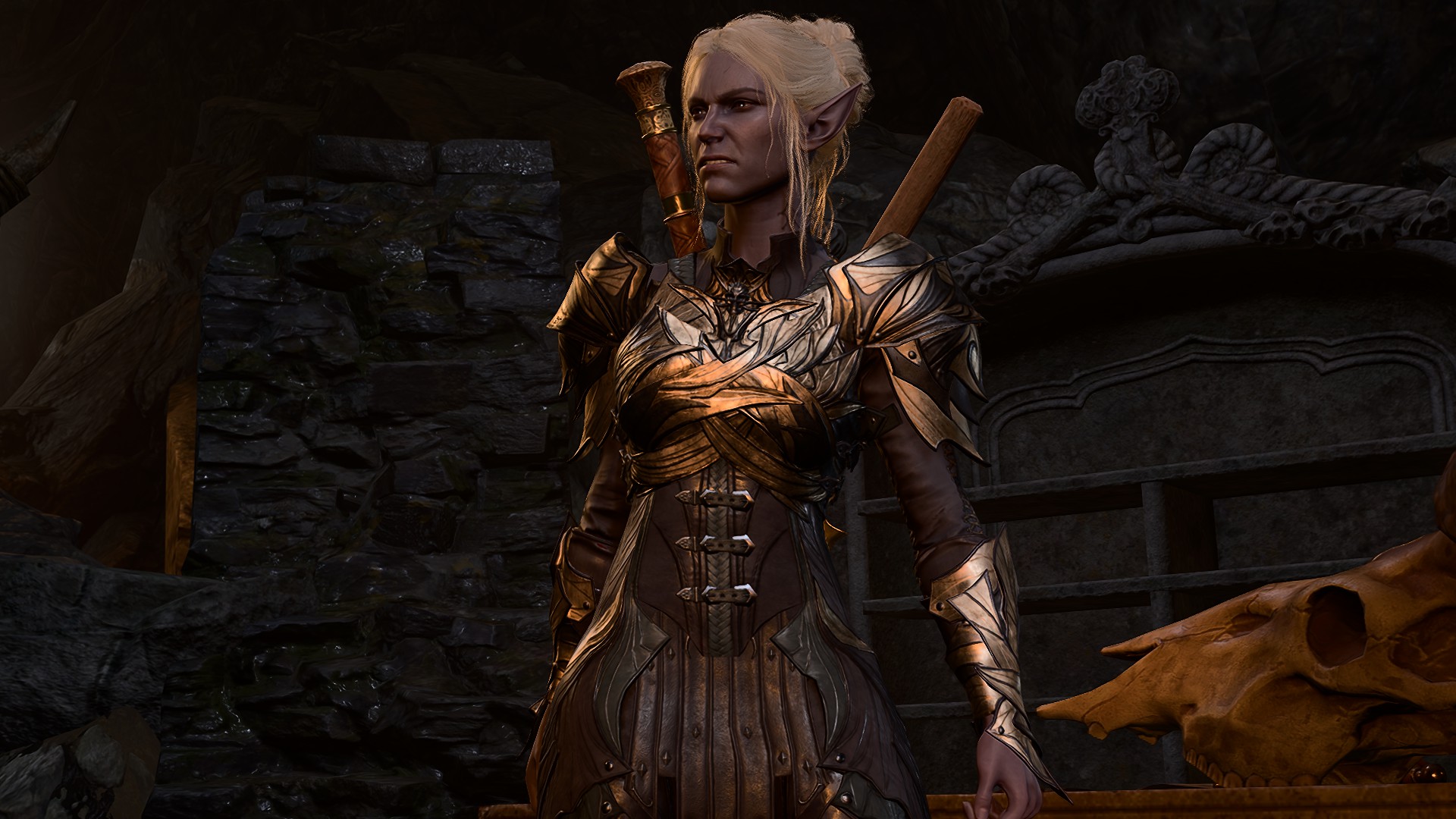
| Level | Class | Selection |
|---|---|---|
| 1 | Paladin | Lay on Hands, Divine Sense, Inquisitor’s Might |
| 2 | Paladin | Searing Smite, Thunderous Smite, Shield of Faith, Divine Favor, Cure Wounds |
| 3 | Paladin | Vow of Enmity, Receives Bane, Receives Hunter’s Mark, Command |
| 4 | Paladin | Feat: Ability Improvement Strength, Protection from Evil and Good |
| 5 | Paladin | Hold Person, Misty Step, Branding Smite |
| 6 | Paladin | Aura of Protection, Magic Weapon |
| 7 | Paladin | Relentless Avenger, Lesser Restoration |
| 8 | Paladin | Feat: Great Weapon Master |
| 9 | Paladin | Haste, Protection from Energy, Blinding Smite, Elemental Weapon |
| 10 | Paladin | Aura of Courage, Revivify |
| 11 | Fighter | Defence Fighting Style, Second Wind |
| 12 | Fighter | Action Surge |
Alternative Minthara Paladin Build
Investing a couple of levels into the Warlock class first will give Minthara access to the powerful Booming Blade cantrip. Then, once you reach level 3, swap back to her usual Paladin class and pick up the Vengeance subclass. With five levels of investment, you will have much more movement speed and melee potential. Finally, at Level 9, you’ll switch to the Fighter and Eldritch Knight subclass for even more spellcasting and melee damage potential.
| Level | Class | Selection |
|---|---|---|
| 1 | Warlock | Hexblade, Shield, Hellish Rebuke, Booming Blade, Eldritch Blast |
| 2 | Warlock | Wrathful Smite, Hex spells, One with Shadows, Devil’s Sight Invocations |
| 3 | Paladin | Multiclass Paladin, Vengeance Subclass |
| 4 | Paladin | Great Weapon Fighting, Command, Thunderous Smite, Divine Favour, Shield of Faith, Cure Wounds |
| 5 | Paladin | Protection from Good and Evil |
| 6 | Paladin | Great Weapon Master Feat, Compelled Duel |
| 7 | Paladin | Drop Compelled, select Magic Weapon, Lesser Restoration |
| 8 | Paladin | Aid spell |
| 9 | Fighter | Multiclass Fighter, Defense Fighting Style |
| 10 | Fighter | Action Surge |
| 11 | Fighter | Eldritch Knight subclass, Chromatic Orb, Magic Missile spells, Bursting Sinew, Fire Bolt cantrips, Longstrider extended |
| 12 | Fighter | Savage Attacker feat, Shield spell |
Complete Minthara Leveling Guide for BG3
Level 1
After you recruit Minthara, she comes with a default class/subclass template. The only thing you cannot change about her is her story along with the race of Drow. However, Drow is a great race for almost any build, and her origin story centers on Paladin, so we are going to keep her in that light. If you wish to break your Oath, check out this Oathbreaker build and progression path. We will assume, for now, that you are playing the Vengeance Paladin which will be listed below.
Minthara will come with some amazing armor straight out the gate, but look to replace it with Heavy Armor after unlocking the Paladin class. For her weapon, look to obtain a two-handed Greatsword.
Paladin Features at Level 1:
- Channeled Oath Charges: Paladin-specific resource that allows the casting of spells and abilities. Used for three oath skills, can be recovered via short rest.
- Lay on Hands: Use your blessed touch to heal a creature or cure it of all diseases and poisons. A single target melee heal using action or cure disease. This consumes Oath Charges but is an effective heal.
- Divine Sense: Gain Advantage on Attack Rolls against celestials, fiends, and undead. This uses a bonus action, which can be used with an attack costing an action.
- Inquisitor’s Might: You or an ally’s weapon attacks deal an additional 2 Radiant damage and can Daze enemies for 1 turn. This is a Channeled Oath skill that can add a bit of damage with a chance to stun, which is helpful.
- Oath of Vengeance Tenets: Fight the Greater Evil. Exerting your wisdom, identify the higher morality in any given instance, and fight for it. No Mercy for the Wicked. Chasten those who dole out their villainy by wiping their blight from the world forever. This isn’t really a mechanical element, just an oath you need to maintain. If you break the oath, you can unlock a new subclass, Oathbreaker.
Gameplay: at this level move along quickly to level 2 for spell unlocks. Use Lay on Hands for healing, Inquisitor’s Might for extra damage, and swing your sword. Refer to the best gear and consumables sections below as we go through each level of the best Minthara build in BG3.
Minthara Gameplay & Priorities
In early levels of BG3, the Vengeance Paladin will have dreadful mobility. Therefore, you need to find and equip a back-bar ranged weapon like a Heavy Crossbow. This gives you some type of upfront damage before you can close the distance. However, at level 5, you will unlock Misty Step and dramatically improve your power and mobility. Moreover, look to acquire Elixir of Hill Giant Strength, Potion of Speed, and Oil of Accuracy consumables. These three consumables “stack,” allowing for massive damage, and your Multiclass Bard will feel very powerful immediately.
Level 2
At level two, the Paladin gains access to five prepared spells, choose a fighting style, and Divine Smite. Here is a list of what to do as a level two Vengeance Paladin:
Divine Smite: Uses a spell slot and hits in conjunction with a weapon strike. Can be automatically applied, only during critical hits or have a popup box via the reactions menu. Be cautious at first about using this too often. You will burn through your spell slots quickly at this low level, and either have to rest or just use melee attacks only.
Read More: Baldur’s Gate 3 Bard College of Valour Build
Paladin Level 2 Prepared Spells:
- Searing Smite: Your Weapon deals an extra 1d6 Fire damage and marks the target with Searing Smite. A target with Searing Smite takes 1d6 Fire damage every turn until it succeeds on a Constitution saving throw. This is your hard-hitting single-target spell that also gives a damage-over-time fire effect. Consider this a good option if you cannot one-shot an opponent and don’t need to Crowd Control them.
- Thunderous Smite: Your weapon rings with thunder as you strike, pushing your target 3m away and possibly knocking it Prone. This attack can act like Crowd Control when you need a stun. You want to use this when needing a stun on a hard-hitting enemy.
- Shield of Faith: Surround a creature with a shimmering field of magic that increases its Armour Class by 2. This uses a bonus action and requires concentration and should be used before fights where you expect to take the majority of the damage.
- Divine Favor: Your prayer empowers you with divine radiance. Your weapon attacks deal an additional 1d4 Radiant Damage. This spell is great because it consumes a bonus action, not an action. This also gives you additional Radiant Damage, which you can pair with Divine Smite for huge damage early in the game. Concentration is required with this spell.
- Cure Wounds: Touch a creature to heal it. A decent melee-based heal that consumes an action and spell slot. Early in the game, not having healing or potions spells doom, and depending on group composition, this spell can be flexed in or out.
Paladin Gameplay Changes
Great Weapon Fighting: A passive feature when you roll a 1 or 2 on a damage die for an attack with a Two-Handed melee weapon, that die is rerolled once. This minimizes low-damage rolls and keeps your damage high especially using a Two-Handed weapon like a Greatsword.
With all of these spells, it’s important to not use them liberally. Divine Smite can proc (consuming an extra spell slot) and deliver extra damage in combination with Searing Smite. So if you Critical Strike with Searing Smite, you can use the reaction Divine Smite for additional damage. This will consume two spell slots, but deal a lot of damage. Early in the game, this is an issue due to the lack of spell slots. So be careful, don’t waste these spell slots on a target with 8 health, just melee attack them.
Additionally, Minthara makes great use of her bonus action early in the game. Using Shield of Faith or Divine Favor prior to a fight can be helpful. Shield of Faith can be helpful to allies as well. Use healing sparingly, you should be focused on damage and bring a support class along for healing and buffs.
Paladin Level 2 Prepared Spells: Searing Smite, Thunderous Smite, Shield of Faith, Divine Favour, Cure Wounds.
Read More: Baldur’s Gate 3 Shadow Magic Sorcerer Build
Level 3

At level three the Vengeance Paladin will unlock another level 1 spell slot, Divine Health, and subclass features. Here’s a list of what happens as a level 3 Paladin:
- Gain Divine Health: prevents disease from affecting you (passive benefit).
- Abjure Enemy: Frighten an enemy. They’ll be easier to hit and cannot move. Fiends and undead have Disadvantages on this Saving Throw. This is a subclass skill that can be helpful when enemies are likely to move away, should be Fiends and Undead click examine if unsure.
- Vow of Enmity: Gain Advantage on Attack Rolls against an enemy. Advantage gives two D20 rather than one, likely increasing your damage significantly, but there are usually better offensive buffs.
- Receives Bane: Up to 3 creatures receive a -1d4 penalty to Attack Rolls and Saving Throws. Should be used sparingly as a Paladin, multiple target debuff that makes enemies more likely to miss. You receive this from your subclass, and do not need to prepare it.
- Receives Hunter’s Mark: Mark a creature as your quarry to deal an additional 1d6 Slashing Damage whenever you hit it with a weapon attack. If the target dies before the spell ends, you can mark a new creature without expanding a Spell Slot. A great debuff spell single target and you can reapply after a kill for free with a bonus action. Worthwhile to cast Divine Favor as a bonus action offensive tool.
- Command: Command a creature to flee, move closer, freeze, drop to the ground, or drop their weapon. This is your crowd control ability that can be used at range. My favorite is prone, taking away action and bonus action from a hard-hitting enemy. Take this if you have another support character with you.
Vengeance Subclass Gameplay
You now have a lot of versatility in spells, skills, and actions. The premise here is to use bonus actions and actions effectively per turn. At this level, I rarely use Thunderous or Searing Smite. It consumes both action and bonus action which is very costly. The first turn, I usually buff with Divine Favour or Shield of Faith, then attack in melee. The following turn, I decide on priority. If we need a stun, Command is a great option. Or if I just have to kill a target, I’ll use my spell slots for Searing Smite. Otherwise, if we need high damage and a single target stun, Thunderous Smite. Generally, I melee attack and try to use Hunter’s Mark as my bonus action if my concentration spell falls off (Divine Favour or Shield of Faith).
Even at level 3, the Paladin can be complex. Buff turn one, and use burst damage turn two. Turn three and evaluate what your group needs, crowd control, burst, healing, etc. Rinse and repeat that model until later in the game. It will get easier and more effective as you unlock spell slots. Also, check if you have a bonus action spent before ending your turn. Keeping it simple and attacking using your Smite and Spell slots for melee damage is a great way to play our best Minthara build for Baldur’s Gate 3.
Paladin level 3 Prepared Spells: Searing Smite, Thunderous Smite, Shield of Faith, Divine Favour, Cure Wounds, Command.
Level 4

Level four gives you a very important decision between increasing your ability score like Strength or taking a feat. Feats give you a big benefit but doing so will have you miss out on Ability Improvements. Simply increasing your main stat Strength to 18 is the simplest and easiest way to advance your character. You can do this by selecting ability improvement rather than +2 to strength.
At level 8 we will take Great Weapon Master and at level 12 (max level in Baldur’s Gate 3) we will take another +2 to Strength. This will keep our build simple at the moment, and we will hit hard with a better percentage chance with a melee weapon.
You get one additional spell to slot and I recommend Protection from Evil and Good.
- Protection from Evil and Good: Protect an ally against the attacks and powers of aberrations, celestials, elementals, fey, fiends, and undead. The target can’t be Charmed, Frightened, or possessed by them, and when these creatures attack it, they do so with a disadvantage. This is a niche spell for this build and is not used often. It comes in handy in particular fights where your character is crowd-controlled on turn one and does nothing but sit there charmed. Otherwise, take another skill you find more appealing and consider this a flex.
Gameplay remains unchanged at this level. Expect more damage and better chances to land an attack. Keep leveling to get more spells and more spell slots.
Level 4 Paladin Prepared Spells: Searing Smite, Thunderous Smite, Shield of Faith, Divine Favour, Cure Wounds, Command, Protection from Evil and Good.
Level 5
At level 5, the Paladin and Oath of Vengeance subclass unlocks a lot. Extra attack, more spell slots and two subclass spells. Here’s a list of what to expect as a level 5 Paladin in Baldur’s Gate 3:
- Level 1Spell Slot Unlocked
- Level 2 Spell Slot Unlocked
- 1 Extra Prepared Spell (take Branding Smite)
- Extra Attack: Beginning at level, you can attack twice, by the Attack action on your turn. This combined with Divine Smite and the added spell slots allows you to mega single target damage pure turn.
- Subclass Spells:
- Hold Person: (Subclass Feature)(Hold a humanoid enemy still. They can’t move, act or react. Attacks from within 3m are always Critical Hits. 10 Turns)
- Misty Step: (Subclass Feature)(Surrounded by silver mist, you teleport to an unoccupied space you can see.)
Spell
- Branding Smite: deals 2d6 radiant damage and Possibly marks your target with light, preventing it from turning Invisible. Another hard-hitting Smite with 2d6 radiant this makes it perfect against specific targets. Don’t sleep on the preventing from turning invisible. Beyond level 5, many enemies and bosses will attempt to slip away invisible with a potion or a spell.
Extra Attack and Mobility Boost
Level 5 unlocks a lot of offensive and defensive potential for the Paladin. Extra Attack gives you two attacks in one with a chance to proc Divine Smite on each. You can also combo this with a Potion of Speed or the Haste spell for two actions per turn. Your bonus action can be used for debuffs, and at level 8, another attack. You have two free spells courtesy of the Vengeance subclass. The best is Misty Step. The strength is this spell gives you great mobility and only uses bonus action. Now you can close the gap, charge in and have great mobility alongside huge single-target damage.
At this level and beyond, you should feel very powerful. You can buff and debuff with a bonus action, mobility with Misty Step, and huge damage for the scenario or enemy using Smite. The issue with the build at this point is spell slots and using your big damage Divine Smite reaction appropriately. You will also need to take Long Rests frequently. Do not go off wandering into the unknown without your spell slots full.
Level 5 Paladin Prepared Spells: Searing Smite, Thunderous Smite, Shield of Faith, Divine Favour, Cure Wounds, Command, Protection from Evil and Good, Branding Smite.
Level 6
At level 6 the Paladin unlocks 1 more prepared spell bringing the total to 9. You also get Aura of Protection.
- Aura of Protection: You and nearby allies gain a bonus to Saving Throws equal to your charisma modifier.
Spell
- Magic Weapon: Infuse a weapon with arcane energy. The weapon becomes magical, receiving a +1 bonus to Attack and Damage Rolls. This is a decent buff to damage, but it comes at the cost of a high-level spell slot and concentration. Another decent spell to add to our arsenal.
Once you unlock Aura of Protection you need to activate it for its effect. Gameplay not much changes at this level.
Ending Act 1 with Minthara
Around level 6, you should be nearly finished with Act 1 content. Before moving on make sure to check merchants and stock up on camp and alchemy supplies. Moreover, look over the list of best Act 1 items. Additionally, try to get all of the permanent bonuses available in Act 1. Lastly, Grymforge has powerful armor and weapons (Adamantine) that can aid you well into Act 3. Consider taking the time to collect the crafting items before transitioning to Act 2, where you won’t be able to return (Moonrise Tower).
Paladin Level 6 Prepared Spells: Searing Smite, Thunderous Smite, Shield of Faith, Divine Favour, Cure Wounds, Command, Protection from Evil and Good, Branding Smite, Magic Weapon.
Level 7

At Level 7 Paladin Unlocks:
- Relentless Avenger: (Subclass Feature)(If you hit an enemy with an Opportunity Attack, your movement speed increases by 4.5m on your next turn.)
- Additional Level 3 spell slot.
Spell
- Lesser Restoration: Cure a creature from disease, poison, paralysis, or blindness. This is used in rare circumstances, but when an ally is critically paralyzed, and you need them to be able to take a turn.
Gameplay for Level 7 of our Best Minthara Companion Build Guide: Not much changes and we are about to level 8 for a BIG boost in power with one of my favorite feats in the game.
Paladin Level 7 Prepared Spells: Searing Smite, Thunderous Smite, Shield of Faith, Divine Favour, Cure Wounds, Command, Protection from Evil and Good, Branding Smite, Magic Weapon, Lesser Restoration.
Level 8
At level 8 the Paladin gets to pick a Feat or Ability Improvement, we suggest taking Great Weapon Master.
Great Weapon Master feat which does the following: When a melee attack scores a critical hit or kills a creature, you can make another melee attack as a bonus action. When attacking with Heavy Weapons you are proficient with, attack rolls take a -5 penalty, but their damage increases by 10.
The Great Weapon Master feat does two things for you. One, it has a high-risk high reward ability to add 10 damage BUT -5 attack roll penalty. As shown in the picture above, this simply reduces your chance to hit the percentage significantly. You can turn this off in the Passive section on your toolbar, which will give you the normal percentage.
Secondly, this feat gives you another chance to hit on a kill or critical hit using a bonus action. This is the real reason the feat is so strong, multiple attacks in a turn, and with this build, you will be getting a lot of critical hits and kills. Combat should therefore be initiated using your action first, saving your bonus action for a Great Weapons Master attack.
Great Weapon Master Usage
At level 8 you now have the god-tier Great Weapon Master and enough strength to take advantage of it. Here’s how you want your turn to go after you are buffed:
- Action One Attack (proc Divine Smite) goal kill target or critical strike
- Action Two Attack (proc Divine Smite) goal kill target or critical strike
- Proc Great Weapon Master from kill or critical hit, then use bonus action for another attack (proc Divine Smite).
That is a lot of attacks without using a specific Smite because the bonus action can proc Great Weapon Master. This doesn’t mean you shouldn’t use Branding, Thunderous, or Searing Smite, it’s just now you have options considering your bonus action is so valuable.
You can take this a step further by using a Potion of Speed or have someone cast Haste on you. This will give you an additional action, two more attacks and possibly two more divine strikes. In one turn, if things go well, the Paladin is an absolute force with this setup. Buff with bonus action on the first turn, and use primary melee attacks on the second with the goal of proc Great Weapon Master. Use your Smites and spell slots when you need a big damage attack. Heal rarely, and Misty Step for mobility.
Level 8 Paladin Prepared Spells: Searing Smite, Thunderous Smite, Shield of Faith, Divine Favour, Cure Wounds, Command, Protection from Evil and Good, Branding Smite, Magic Weapon, Lesser Restoration.
Levels 9
The level 9 Oath of the Vengeance Paladin unlocks 2 Level 3 Spell Slots and two subclass-specific spells.
- Haste (subclass spell): Target yourself or an ally to become Hastened. The creature has a +2 bonus to Armour Class, Advantage on Dexterity Saving Throws, its Movement Speed is doubled, and can take one additional Action per turn. When the condition ends, the creature becomes Lethargic. This is one of the best spells in the game because it increases actions. The downside of the Paladin using it, it takes action and a much-needed level 3 spell slot. I prefer to use Potion of Speed which gives the same effect for fewer turns.
- Protection from Energy (subclass spell): Most of our level 3 spells will be used for Smite or Elemental Weapon, but this can save your life in very specific fights with heavy single-focus elements. Otherwise, consider this a utility skill.
- Blinding Smite: +3d8 radiant damage and possibly Blind your target. This spell is your big nuke using Smite along with Blind it makes it a must-have and our primary usage of level 3 spells.
- Elemental Weapon: Imbue a weapon with elemental power. It receives a +1 bonus to Attack Rolls, and deals an additional 1d4 damage of your choice. Consider this an enhanced Divine Favour adding +1 to attack rolls as well. The downside is it cost an action and a level 3 spell slot. However, if you can pre-buff using this before a fight expect even more damage.
Gameplay at Level 9
At this level you have even more in your arsenal. Most of the added spells will be used in niche situations. Your bread and butter remains the same, Smite damage. With Blinding Smite you have a hard counter against fellow martial weapon users. Giving the Blind debuff alongside 3d8 radiant damage is massive. Keep things simple with out Best Minthara Companion Build Guide and use your off-healing, crowd control and utility only when needed.
Note on prepared spells, make sure to drop Compelled Duel so you can pick up two level 3 spells.
Level 9 Paladin Prepared Spells: Searing Smite, Thunderous Smite, Shield of Faith, Divine Favour, Cure Wounds, Command, Protection from Evil and Good, Branding Smite, Magic Weapon, Lesser Restoration, Blinding Smite, Elemental Weapon.
Levels 10
At level 10, the Paladin unlocks the following in Baldur’s Gate 3:
- Lay on Hands Charge
- Aura of Courage: You and any nearby allies can’t be Frightened. The aura disappears if you fall Unconscious.
- 1 Spell (take Revivify)
- Revivify: Revive a companion. They return to life with 1 hit point. Typically you can throw potions or use the help function but this can be useful for long range to bring someone back.
Gameplay remains unchanged at this level with more utility.
Level 10 Paladin Prepared Spells: Searing Smite, Thunderous Smite, Shield of Faith, Divine Favour, Cure Wounds, Command, Protection from Evil and Good, Branding Smite, Magic Weapon, Lesser Restoration, Blinding Smite, Elemental Weapon, Revive.
Level 11

At level 11 the Paladin doesn’t get much beyond an extra spell and another level 3 spell slot. I recommend spending the last two levels multi-classing this class. Investing two levels into Fighter will give you a passive +1 Armour Class (AC) for using armor and a god-tier skill, action surge. If you want to stick with Paladin, you can choose another spell at this level and at level 12 pick +2 Strength feat. However, I suggest taking two levels into Fighter to increase your action potential, which increases your damage significantly.
Having 20 strength with another ability improvement is great. However, you get even more with potions of Hill Giant, 21 and 27 depending on the usage. I typically do not recommend mulit-classing, but the Paladin can really benefit from another action once per fight.
- Defence Fighting Style: While you are wearing armor, you gain a +1 bonus to AC. This is a passive benefit at level 1 Fighter and will help with survival.
- Second Wind: this skill is unlocked at level one Fighter and is a mediocre heal that is useful during the start of the game. You can use a bonus action, though most potions outperform it.
If you multi-class, this level will feel uneventful, but trust me it’ll be worth it. Prepared Spells remain unchanged from here on out.
Level 12

For our final Level in our Best Minthara Companion Build Guide, you want to put another level into your multiclass. With two levels into Fighter, you get access to the awe-inspiring Action Surge. You get an extra action, but the biggest strength is, it doesn’t require any resource to use it. Action Surge is a once-per-fight usage, but it allows you to cast another spell, attack, dash, etc. It gives you that extra oomph that no other class has.
You take your Paladin with Extra Attack and give it Action Surge for 2x more attacks. You can take this a step further by using either a Potion of Haste or casting Haste on yourself. Then you get another action! If you did the math on that:
- Attack one + extra attack = 2
- Attack two (via Action Surge) + extra attack = 4
- Attack three (via Haste) + extra attack = 6
- Great Weapon Master via critical strike or kill = 7 (if you have a bonus action)
The Paladin at level 12 with this setup has so much firepower it’s remarkable. Again, if you wanted a traditional Paladin for all 12 levels, take ability improvement +2 Strength or the Alert feat which helps with going early. We hope you enjoyed this build and check out the gear section for more.
Best Gear for Minthara Companion Build in Baldur’s Gate 3
Beginner: Starting the Game
Here’s the best beginner gear for the Minthara Paladin build in BG3 Act 1:
| Gear Slot | Best Gear Item | Effect |
|---|---|---|
| Head | Helmet of Smiting | Smite gives HP |
| Cape | – | |
| Chest | Adamantine Splint Armour | 18 AC |
| Gloves | Gloves of the Growling Underdog | Advantage on Melee |
| Boots | Disintegrating Night Walkers | Free Misty Step |
| Necklace | Moondrop Pendant | No Opportunity Attacks |
| Ring | Crusher’s Ring | Increase Movement |
| Ring | Caustic Band | Poison Damage |
| Weapon 1 Main Hand | Sword of Justice | 2d6 Slashing |
| Weapon 2 Ranged | Titanstring Bow | Add STR modifier |
Below are the best alternative Act 1 armour, weapons, and equipment for the Minthara build in BG3:
- Helmet of Smiting: Located in Underdark Selûnite Outpost X: 163 Y: -248 (Alternative Haste Helm).
- Adamantine Splint Armour: Can be crafted at Grymforge (Alternative Chain Mail +1, or Githyanki Half Plate).
- Gloves of the Growling Underdog: Chest behind Razglin’s throne room. (X295 Y69) (Alternative Gloves of Archery, Gloves of Dexterity, or Gloves of Hail of Thorns).
- Disintegrating Night Walkers: Looted or stolen from Nere in Grymforge (Alternatives Boots of Striding, or Boots of Genial Striding).
- Amulet of Misty Step: Chest behind the ogre Polma in the Defiled Temple within the Goblin Camp (Alternative Moondrop Pendant).
- Crusher’s Ring: Looted or stolen from Crusher in the Goblin camp (Alternatives Ring of Flinging, or The Sparkswall).
- Caustic Band: Sold by Derryth Bonecloak at Myconid Colony, Underdark (Alternatives Fetish of Callarduran Smoothhands, or Ring of Absolute Force).
- Sword of Justice: Looted from Anders in the Risen Road Toll House (Alternative Silver Sword of the Astral Plane or Everburn Blade.
- Hunting Shortbow: Sold by Dammon in the Druid Grove.
- Titanstring Bow: Brem in Zhentarim Hideout Act 1 (Alternative Giantbreaker).
Advanced: End-Game
The following table presents the advanced and end-game gear for the best Minthara build in Baldur’s Gate 3 Act 3:
| Gear Slot | Best Gear Item | Effect |
|---|---|---|
| Head | Helm of Balduran | Self-healing |
| Cape | Fleshmelter | Return Damage |
| Chest | Helldusk Armour | 21 AC |
| Gloves | Gauntlets of Hill Giant Strength | 23 Strength |
| Boots | Helldusk Boots | Mobility |
| Necklace | Amulet of Greater Health | 23 Constitution |
| Ring | Killer’s Sweetheart | Auto Critical |
| Ring | Ring Of Regeneration | Self-healing |
| Weapon 1 Main Hand | Balduran’s Giantslayer | Best Greatsword |
| Weapon 2 Ranged | Darkfire Shortbow | Gives Haste |
Below are the best alternative end game armour, weapons, and equipment for Minthara in BG3:
- Helm of Balduran: Found in Dragon’s Sanctum X: 636 Y: -964 (Alternatives Helldusk Helmet, Sarevok’s Horned Helmet, or Mask of Soul Perception).
- Fleshmelter Cloak: Looted from Aelis Siryasius in the Lower City Sewers in Act 3 (Alternative Cloak of Protection)
- Helldusk Armour: Dropped by Raphael in the House of Hope (Alternative: Armour of Persistence).
- Gauntlets of Hill Giant Strength: Obtained in Archive of the House of Hope (Alternatives Legacy of the Masters, Gloves of Soul Catching, or Helldusk Gloves).
- Helldusk Boots: Wyrm’s Rock Fortress X: -32 Y: 219 Act 3 (Alternative Disintegration Night Walkers).
- Amulet of Greater Health: Looted from the Archive in the House of Hope (Alternatives Surgeon’s Subjugation Amulet, or Periapt of Wound Closure).
- Killer’s Sweetheart: Obtained from the Self-Same Trial in the Gauntlet of Shar in Act 2 (Alternatives Ring of Protection, or Risky Ring).
- Ring of Regeneration: Found in Lorroakan’s Projection store (Alternatives Shifting Corpus Ring, or Ring of Free Action).
- Balduran’s Giantslayer: Obtained as a reward for completing the Wyrmway trials, Act 3. (Alternative Sword of Chaos)
- Darkfire Shortbow: Sold by trader Dammon Act 2 Last Light Inn, Act 2.
Best Minthara Build Consumables, Potions, and Items in BG3
The following list represents the best individual use consumable items that will enhance our best Minthara BG3 build:
- Elixir of Bloodlust: Once per turn when you kill a foe, you gain HP 5 temporary hit points and an additional action.
- Elixir of Hill Giant Strength: Increases Strength ability score to 21 until Long Rest.
- Potion of Speed: Gain extra action, +2 AC, Advantage on Dexterity Saving Throws, and double movement speed.
- Drow Poison: Weapon poison that adds Constitution Saving Throw or becomes Poisoned and falls Asleep.
- Potion of Flying: Drink to gain a flying speed of 60ft for one hour.
- Elixir of Heroism: Gain 10 temp HP and become Blessed until a long rest.
- Potion of Greater Healing: 4d4 + 4 hit points restored.
- Oil of Accuracy: Coat Weapon. Bonus of +2 in Attack Rolls.
- Elixir of Vigilance: Drink to gain a +5 bonus to Initiative and you can’t be Surprised.
- Elixir of Darkvision: (only non-Darkvision race): Drink to gain the ability to see in the dark up to 12m.
Combat, Gameplay, and Tips for our Minthara Build in Baldur’s Gate 3
Here are 10 gameplay tips specifically for playing our Minthara build in BG3:
- Spell Slots: use your spell slots wisely, especially for Divine Smite and Healing
- Divine Smite: use this extra damage source on the hardest to defeat enemies and save your spell slots for when you really need it.
- Healing: use potions that consume bonus actions or Lay on Hands for yourself or an ally.
- Heavy Armor: find and equip this early for needed AC.
- Crowd Control: make sure to CC enemies with Thunderous Smite or a Companion ability to limit damage.
- Pre-Buff: have a companion cast blessed prior to combat to get a roll Advantage.
- Range: don’t forget to equip a ranged weapon to ensure you can do damage on nearly every turn.
- Long Rest: use the rest at camp function to regain spell slots and don’t go into a fight with zero.
- Great Weapon Master: focus on low-health targets with your first action to strike a kill and another attack with Great Weapon Master.
- Toggle Reactions: make sure both Divine Smite and Great Weapon Master are toggled on or off when you need them.
Minthara uses the BG3 Paladin Oath of Vengeance build for a combination of melee, single target damage, healing, and crowd control to survive. You will need to initiate combat, use consumables to replenish health, and rely on other companions or your main character for what your classes don’t have available.
Baldur’s Gate 3 Minthara Companion Build Summary Guide
Recruit Minthara
- Shattered Sanctum in Goblin Camp
Subclass – Oath of Vengeance
Preferred Weapon: Greatsword
Preferred Armor: Heavy
Race – Drow
Best Early Action – Divine Smite
Best Late Action – Action Surge
Minthara Abilities Score
- Strength: 16
- Dexterity: 10
- Constitution: 14
- Intelligence: 8
- Wisdom: 10
- Charisma: 16
- Level 4 – +2 Strength
- Level 8 – Great Weapon Master
Multiclassing
- Fighter at Levels 11 & 12
Looking For More About Baldur’s Gate 3?
Thank you for reading our Minthara build guide for BG3. We provide the latest news and create guides for Baldur’s Gate 3. Also, watch me play games on Twitch or visit my YouTube channel!
- Best Baldur’s Gate 3 Multiclass Paladin Build
- Best Baldur’s Gate 3 Oath of the Crown Paladin Build
- BG3 Tier Lists and Rankings All BG3 Builds
- All BG3 Classes, Companions and Multiclassing
- All BG3 Comprehensive Guides
- All Permanent Bonuses You Should Get in BG3
- Act 1 Checklist for Baldur’s Gate 3
- Act 2 Checklist for Baldur’s Gate 3
- Act 3 Checklist for Baldur’s Gate 3
 Reddit
Reddit
 Email
Email
